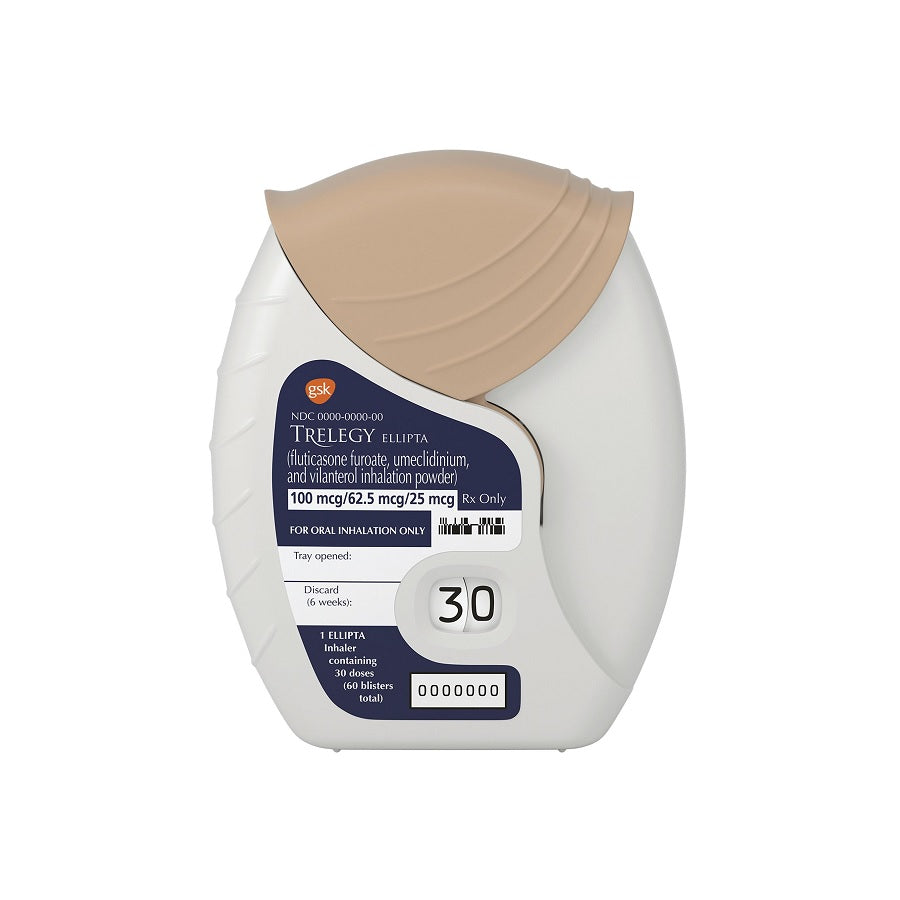GLAXO-SMITH KLINE
TRELEGY ELLIPTA (Fluticasone Furoate/Umeclidinium/ Vilanterol)
TRELEGY ELLIPTA (Fluticasone Furoate/Umeclidinium/ Vilanterol)

Couldn't load pickup availability
What is this medication?
Fluticasone Furoate+Umeclidinium+Vilanterol, Trelegy Ellipta
Anticholinergic Agent; Beta2 Agonist; Corticosteroid, Inhalant
Indicated for treatment of asthma, and chronic pulmonary obstructive disease (COPD).
How does this medication work?
Trelegy Ellipta is an inhaler that combines fluticasone furoate, umeclidinium, vilanterol which is used for the long-term treatment of COPD, chronic bronchitis, emphysema and asthma.
Fluticasone Furoate is a corticosteroid with anti-inflammatory activity, immunosuppressive properties, and antiproliferative actions.
Umeclidinium acts as a reversible, competitive antagonist of the acetylcholine at type 3 muscarinic (M3) receptors in bronchial smooth muscle causing bronchodilation.
Vilanterol is a long-acting beta-2 agonist, relaxes bronchial smooth muscle by selective action on beta-2 receptors with little effect on heart rate.
What should I watch for while using this medication?
Before using Fluticasone Furoate+Umeclidinium+Vilanterol, Trelegy Ellipta make sure your physician is aware of any allergies or medications you currently take, pre-existing medical conditions and activities you perform. Fluticasone furoate is a corticosteroid that can cause hypercortisolism or suppression of hypothalamic-pituitary-adrenal (HPA) axis, including adrenal crisis. Paradoxical bronchospasm that may be life-threatening may occur with use of inhaled bronchodilating agents; if bronchospasm occurs, discontinue Trelegy Ellipta. There has been an increase in the incidence of pneumonia and other lower respiratory tract infections (some fatal) in patients with COPD. Monitor and watch closely for pneumonia. Local oropharyngeal candida infections have been reported; if this occurs, treat appropriately while continuing fluticasone therapy. Patients should be instructed to rinse mouth with water without swallowing after each use. Use Fluticasone Furoate+Umeclidinium+Vilanterol, Trelegy Ellipta with caution in patients at risk or have osteoporosis, cardiovascular disease, diabetes, glaucoma and/or cataracts, benign prostatic hyperplasia/bladder neck obstruction, hypokalemia, seizure disorders and thyrotoxicosis.
How should I take this medication?
Usual (Inhaler): Use one inhalation once daily.
How to Take: For oral inhalation only; administer at the same time each day. Do not open the cover of the inhaler until ready for use; each time the cover is opened, 1 dose of medicine is prepared. Exhale fully before taking one long, steady, deep breath through the mouthpiece (do not breathe through nose); hold breath for 3 to 4 seconds and exhale slowly and gently. Following administration, rinse mouth with water after use (do not swallow). If the mouthpiece needs cleaning, wipe with a dry tissue.
What if I miss a dose?
If you miss a dose of medication, try to take it as soon as possible. However, if it is almost time for your next dose, take only that scheduled dose. Do not take double or extra doses.
Do not use more than 1 inhalation in a single day.
How should I store this medication?
Keep out of the reach of children at all times. Store at room temperature away from moisture, heat, and light. Keep the inhaler device in the sealed foil tray until ready to start using it.
Discard device 6 weeks after it is removed from the foil tray or when the dose counter reads “0” (whichever comes first).
What are the possible side effects of using this medication?
Headache, voice disorder, diarrhea, dysgeusia, constipation, oral candidiasis, gastroenteritis, urinary tract infection, influenza, back pain, arthralgia, pneumonia, bronchitis, pharyngitis, rhinitis, sinusitis, upper respiratory tract infection, cough, oropharyngeal pain
Note this is not a complete list of side effects, only the most common.




